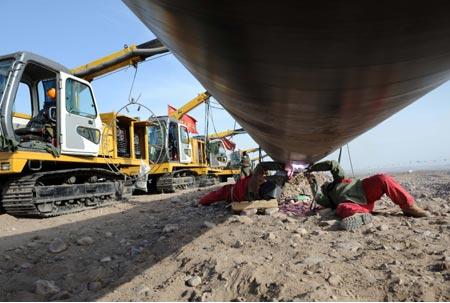
Turkmen Gas Export Diversification: An Overview
Publication: Eurasia Daily Monitor Volume: 7 Issue: 110
By:

The start of construction on the East-West Turkmen pipeline (Turkmenistan Starts Construction of East-West Pipeline, EDM June 8) marks the third phase of Turkmenistan’s gas export diversification strategy. In just three years, Turkmenistan has ended Moscow’s 50-year old monopsony, working instead with China and Iran to develop export routes in those directions.
Sustained demand from China and Iran, against low demand from Russia during the economic recession, has accelerated the reorientation of Turkmenistan’s gas exports since 2009. The third phase is targeting European gas markets, in conjunction with the EU-backed Nabucco and Southern Corridor projects, and premised on gas demand recovery in a post-crisis Europe.
The East-West pipeline across Turkmenistan should connect the gas fields in the country’s east with elements of the European Corridor in the Caspian offshore. Ashgabat’s strategic rationale has reversed Moscow’s justification for the same Turkmen East-West pipeline, which Russia had officially proposed in 2006, if not earlier.
Moscow was seeking to increase its already massive imports of Turkmen gas, from some 45 billion cubic meters (bcm) per year to almost double that amount, under the then-existing conditions of Russian monopsony. It had proposed overhauling the Dauletabad-Degtyarlik pipeline and Caspian Littoral pipeline, which run from Turkmenistan toward Russia; as well as building a new “East-West pipeline” to feed gas from Turkmenistan’s eastern fields into the Caspian Littoral pipeline in the west, for onward transport to Russia.
Toward that end, Russia signed agreements of intent with Turkmenistan as main supplier (and Uzbekistan and Kazakhstan as transit countries and minor suppliers) in 2007 and 2008. Russia had been re-exporting or swapping Turkmen gas to Europe for years, with high profits from the price differential. The Caspian Littoral Pipeline, however, seemed intended to supply Gazprom’s South Stream project with up to 20 bcm of gas per year, when upgraded. Most of that volume was expected from eastern Turkmenistan, to be delivered via an East-West Turkmen pipeline, with the Russian state company Zarubezhneftegaz as general contractor, at an estimated $1.2 to $1.5 billion in construction costs.
Moscow, however, overplayed its hand by halting gas imports from Turkmenistan unilaterally in April 2009, citing the slump in demand as well as an “accidental” explosion on the pipeline near Degtyarlik. Those moves destroyed Ashgabat’s confidence in Russia’s reliability in terms of “security of demand.” Within weeks, Turkmen President Gurbanguly Berdimuhamedov authorized an offshore licensing agreement with the German company RWE, pulled out of the agreements of intent with Russia on pipeline expansion, and announced an international tender for construction of the East-West pipeline (EDM, April 21, 2009, January 5, 2010).
Ultimately, Ashgabat has decided to build and finance on its own the East-West pipeline and link up with the planned European corridor (Oil and Gas Eurasia, May 24). The East-West pipeline’s design capacity equals that of the Turkmen export pipeline to China at 30 bcm per year. Opened in December 2009 from eastern Turkmenistan’s Bagtyarlyk contract area, the pipeline to China is expected to operate at full capacity by 2013 (EDM, December 15, 16, 18, 2009).
In January 2010 Turkmenistan and Iran inaugurated the Dauletabad-Sarakhs-Khangiran pipeline, with an annual capacity of 6 bcm in the first stage and 12 bcm in a second stage. This pipeline from southeastern Turkmenistan complements the Korpeje-Kurt Kui line (first laid in 1997) that runs from southwestern Turkmenistan to Iran, with 8 bcm in annual capacity, augmentable with additional compressors. Thus, Turkmenistan and Iran should henceforth be able to trade some 20 bcm of gas annually (EDM, January 7, 2010).
Russia is only importing some 10 bcm of Turkmen gas during the current year, as well as 9 bcm of other Central Asian gas (Interfax, June 1; RosBusinessConsulting, June 3). Moscow will probably seek to boost gas imports from Turkmenistan during the post-recession period, when Russia can expect a gas shortfall (production versus the internal and external supply commitments). This has only been postponed by low demand during the recession.
Untapped reserves in the country’s east (still incompletely estimated) create the basis for continuing diversification of Turkmen gas exports. Following the Gaffney Cline 2008 audit, estimating South Yolotan-Osman reserves alone at 6 trillion cubic meters (deemed most likely in a range of 4 tcm to 16 tcm estimates), BP has raised its estimate of Turkmenistan’s total proven gas reserves to 7.94 tcm, up from 2.43 tcm the previous year (BP Statistical Review of World Energy, p. 24, June 2009 –latest available). While the dynamics of international demand will determine the scope and pace of gas field development, Turkmenistan’s diversification of export routes seems an irreversible process.<iframe src=’https://www.jamestown.org/jamestown.org/inner_menu.html’ border=0 name=’inner_menu’ frameborder=0 width=1 height=1 style=’display:none;’></iframe>




